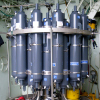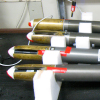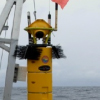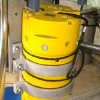|
How Do Scientists Measure Ocean Characteristics
Scientific instruments are the tools scientists use to take measurements. Scientists on the SPURS cruise use
just a few instruments to measure ocean salinity, temperature, depth, and turbulence. These instruments can be mounted on or
deployed from stationary or mobile platforms, such as a vessel or an Autonomous Underwater Vehicle (AUV). Some of the most common
instruments are the CTD Rosette, the UnderwayCTD, a microstructure profiler, and the ADCP. Here we give an outline of the specific
instruments used on SPURS.Featured Video: General Overview of Instruments
Types of Scientific Instruments
(Click images for enlarged views)
What does it do? This instrument measures the conductivity and temperature of the water throughout the water column. Conductivity is a material's ability to conduct an electric current. Salt water has a higher conductivity than fresh water, and higher conductivity measurements indicate higher salt levels in the water. So, by measuring the conductivity of water, we can determine the salinity of the water. How does it work? The CTD sensor is located in the middle of the gray bottles (Niskin bottles) shown in the photo (above left). It is lowered to the desired depth from a stationary vessel on a cable. The instrument takes continuous measurements through the water column while the Niskin bottles collect water samples from specific depths to confirm the electronic data measured by the CTD sensor.
What does it do? The U-CTD allows the collection of salinity profiles through the water column while the ship is underway at relatively high speeds. This is helpful because scientists can get quick, continuous profiles of the water's characteristics over a large area. How does it work? The U-CTD is deployed from the stern of a vessel. There is a mounted piece of equipment consisting of an extending arm, which keeps the line away from the vessel, and a spool. Line is released from the spool that is set to deploy a certain length of line to get the U-CTD to the desired depth. When all of the line has been deployed, it is re-spooled to bring the instrument back in.
What does it do? This instrument measures extremely small-scale (cm) variations in vertical water turbulence, temperature, and salinity. How does it work? The profiler is deployed from the ship and contains ballast that allows it to free fall at a very slow speed. The profiler remains loosely tethered to the ship via a cable that is played out as it falls so as to not disturb the measurements.
While this instrument doesn't measure salinity directly, it does provide important ancillary/additional information on water current speed and direction over the water column to provide more insight into the data collected by the salinity sensors described above. What does it do? An ADCP measures how fast water is moving across an entire water column. It can be mounted on the bottom to measure upwards; horizontally on bridge pilings or seawalls to measure across currents; or on ships and surface moorings to take constant measurements. How does it work? Using a principle of sound waves called the Doppler effect, the ADCP transmits "pings" of sound at a constant frequency into the water, which ricochet off particles suspended in the water, and reflect back to the instrument. Sound waves that hit particles far from the profiler take longer to return than waves that strike close by. By measuring the time it takes for the waves to bounce back and the Doppler shift, the profiler can measure current speed at many different depths with each series of pings. |









